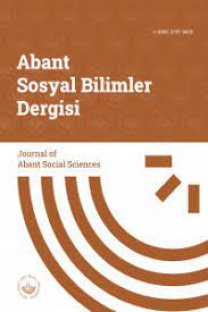Egemen Dillerin Diğer Dilleri Etkisi Altına Alması ve Yabancı Dil Eğitimi
Yabancı dil eğitimi, olil emperyalizmi, çocuklara yabancı clil eğitimi, müfredat geliştirme, malzeme geliştirme, kültür
-
-,
___
- Alptekin, C. (1996). Target—language culture in EFL materials. ln Hedge, T. & Whitney, N. (Eds), Power, Pedagogy and Practice (pp. 53—61). Oxford. OUP.
- Alptekin, C. (2002). Towards intercultural communicative competence. ELI Journal, 56 (l) 57—64
- Baker, C, (1988), Key Issues in Bilingualism and Bilingual Education. Clevedon; Multilingual Matters.
- Bialystok, E. (2001). Bilingualism in Development: Language, Literacy & Cognition. Cambridge: ÇUP.
- Brewster, J . (l996). What is good primary practice? . ln C. Brumfit, l. Moon ve R. Tongue (Eds), Teaching English to Children (1—l7). Essex: Longman. g ()1 an işık Egemen bit'in Diğer Differ; Briem Altına Alması ve Yabancı Dil Eğitimi
- Brown, J" . D. (1995). The Elements of Language Curriculum. Boston, Massachusetts: Newbury House.
- Brurnfit, CJ. (Ed.) (1983). Language Teaching Projects for the Third World. Oxford: Pergamon.
- Byram, M. & Risager, K. (1999). Language teacher. Politics and Culture.
- Clevedon: Multilingual Matters.
- Cameron, L. (2001). Teaching Languages to Young Learners. Cambridge: CUP
- Cameron, L. (2003). Challanges for ELT from the expansion in teaching children. ELT Journal 57 (2) 105—112.
- Chairman, K. (2003). Biliteracy benefits. Literacy Today 37 (21). 21.
- Cummins, I. (1994). Knowledge, power, and identity in teaching English as a second language. In E. Genesee (Ed.), Educating Second Language Children (pp. 33-58). Cambridge: Cambridge University Press.
- Ellis, R. (1994). The Stud of Second Language Acquisition. Oxford: Oxford University Press.
- Enright, SD. (1991). Supporting children’s English language development in grade—level and language classrooms. in M. Celce~Murcia (Ed.), Teaching English as a Second or Foreign Language (386-401). Boston, Massachusetts; HeinledrHeinle.
- Erden. M. ve Akman. Y. (2002). Gelişim ve Ögrenme. Ankara: Arkadas.
- Fasold, R. (1991). The sociolinguistics of Society. Oxford: Basic Blackwell.
- Gass, S. M. & Selinger, L. (1994). Second Language Acquisition. New Jersey; Lawrence Erlbaum Associates.
- Genesee, E. (1994). Educating Second Language Children. Cambridge: Cambridge University Press.
- Graves, K. (1996). Teachers as Course Developers. Cambridge; CUE.
- Graves, K. (2000). Designing Language Courses. Cambridge: CUP.
- Grosjean, E. (1989). Neurolinguists, beware the bilingual is not two monolingual in one person. Brain and Langua e 36, (1) 3=15.
- Haîliwell, S. (1992). Teaching English in the Primary Classroom. Essex: Longman
- Harriers, 3. F. & Blane, M. (1990). Bilinguaiitv and Bilingualism. Cambridge: CUP.
- Işık, A. (2000). The Role of Input in Second Language Acquisition: More Comprehensible Input Supported by Grammar Instruction or More Grammar Instruction. ITL Review of Applied Linguistics. 129—130 225—227.
- İşık, A. (2002). Affective Factors in Language Learning. Doğu Akdeniz University International ELT Conference. May 10, Magusa, Northern Cyprus Turkish Republic.
- McKay's. L. (2000). Teaching English as an international language: implications for cultural materials in the classroom. TESOL Journal. 5 (4) 7~l 1.
- ’) Abant İzzet Baysal Üniversitesi' Sosyal Bilimler Enstitüsü Dergisi 2005-2 (H)
- Modiano, M. (2001). International Journal of Applied Linguistics, ll (2) 159 International Journal of Applied Linguistics, 13 ( 1) 22
- Krashen, S. (1998). What does it take to acquire a language. ESL MagazineŞ (3) 22-23.
- Krashen, S. (2003). Explorations in Language Acquisition and Use. Portsmouth, NH: Heinemann.
- Latham, A. (1998). The advantages of bilingualism. Educational Leadershig 56 (3), 79—80.
- Met, M. (1994). Teaching content through a second language. İn E. Genesee (Ed), Educating Second Language Children (159—182). Cambridge: Cambridge University Press.
- Moon, I. (2000). Children Learning English. Oxford: Macmillan Heinemann.
- Picaî. (2000). Tradition and transition in Engiish teaching methodology. System, 28 1—18.
- Pennycook, A. (1989). The concept of method. interested knowledge, and the politics of language teaching. TESOL ( Zuarterlx. 23 (4) 589—618.
- Pennycook, A. (1990). Towards a critical applied linguistics for the 1990s. issues m Applied Linguistics, l (l) 8—23.
- Penny/cook. A.. (1996). The Cultural Politics of English as an international Language. Essex: Longman.
- Philiopson, R. (1993). Linguistic imgerialisrn. Oxford. 0UP.
- Puchta, H. ve Schratz, M. (1993). Teaching teenageers. Essex: Longman.
- Richards, l. C. (2001). Curriculum Development in Language Teaching. Cambridge: CUP.
- Robinson. P. (2001). Cognition and Second Language instruction. Cambridge: CUP.
- Rogers, 1. (1990). The world for sick proper. in Rossner, R. & Bolitho, R. (Eds), Currents of Change in English Language Teaching (pp. 7—14). Oxford. DUE.
- Scovel, T. (200l). Learning New Languages. Boston, MA: Newhury House.
- Shorrocks, D. (1996). The development of children thinking and understanding. . in C. Brurnfit, J. Moon ve R. Tongue (Eds), Teaching English to Children (260274126). Essex: Longman.
- Though. l. (l996). Young Children learning languages. . in C. Bruin'fit, l. Moon ve R. Tongue (Eds), Teaching English to Children (203—2l2). Essex: Longman.
- Wallace, C. (1997). lELTS: global implications of curriculum and materials design. ELT Journal. 51 (4) 371—373
- Woodward, T. (2002). Planning Lessons and Courses. Cambridge: CUP.
- The European Network of Policy Makers for the Evalauation of Education System. (2002). The Assessment of Pupils’ Skills in English in Eight European Counties. '
- Yayın Aralığı: 3
- Başlangıç: 2000
- Yayıncı: Abant İzzet Baysal Üniversitesi Sosyal Bilimler Enstitüsü
Model of Instructıonal Desing Based on Constructivism and Communication Theory
Türk Tarih Tezi, Amacı, Uygulanışı ve Sonuçları
Evaluation of the Social Impart of Recreational Sports Activities on Orphan Turkish Girls' Attitudes
Müberra ÇELEBİ, Selhan Özbey Alkurt, Dilşad Mirzeoğlu, Serap Şemşek
Türkiye'de İlköğretim ve İnternet
Spor Sponsorluğunda Etkinlik Değerlendirmesi ve Ölçüm Yöntemleri
Meltem VELİOĞLU, Metin Argan, Mehpare Argan Tokay
Osmanlı Arşiv Kaynaklarına Göre Dimitsana'nın Demografik Yapısı
Fındık Tarımı ve Ekonomisi Üzerine Bir Araştırma
Dilşad MİRZAOĞLU, Fatih Efe, Uğur Doğan
Kültür Tipini Yordayan Lider Davranışları
Yeni Yasal Düzenlemeler Işığında Yerel Yönetimlerde Yeniden Yapılanma
